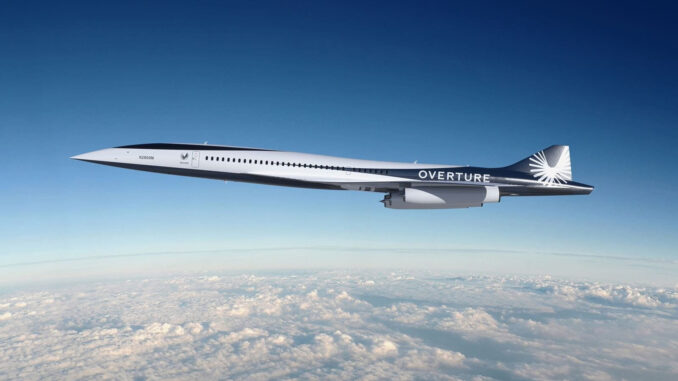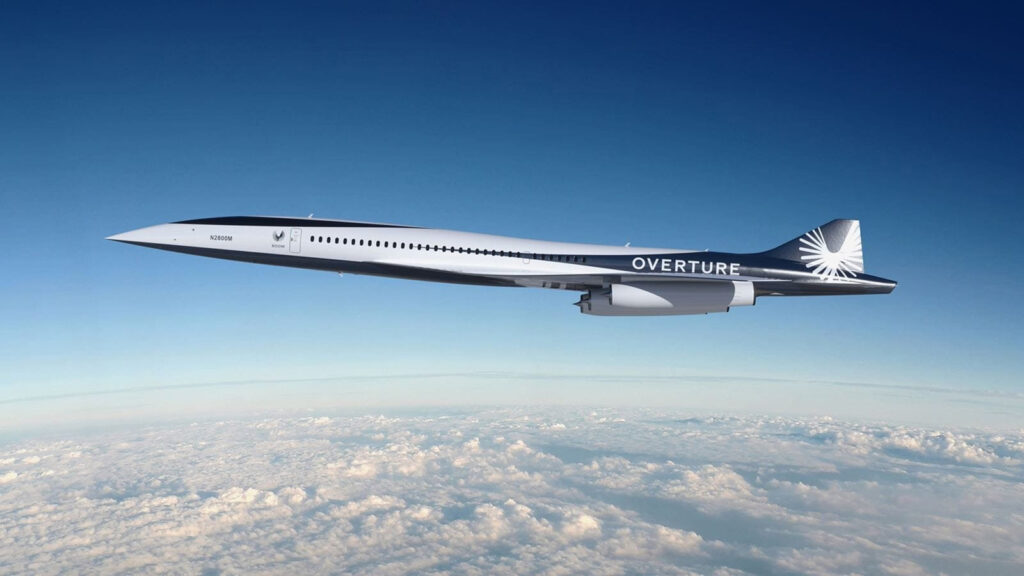
Technical analysis of the second test flight of Boom Supersonic’s XB-1 supersonic prototype and its role in the development of the Overture aircraft.
Boom Supersonic’s XB-1 supersonic aircraft prototype has completed its second test flight, reaching an altitude of 3,170 metres and a speed of 446 kph. The flight was used to test the landing gear and a new stabilisation system, marking a step forward in the development of the Overture commercial supersonic aircraft. The latter aims to revolutionise air transport by offering much faster and more efficient flights than current aircraft.
XB-1 test flight: a significant step forward for Boom Supersonic
On 26 August 2024, Boom Supersonic reached a new milestone in the development of its prototype supersonic aircraft, the XB-1, by successfully completing its second test flight. The 15-minute flight took place from the Mojave Air and Space Port in California, an area well known for advanced aerial testing. During this flight, the XB-1 reached an altitude of 3,170 metres and a speed of 446 km/h, demonstrating its take-off, landing and manoeuvrability capabilities.
This second flight had several technical objectives. The most important of these was to test the landing gear retraction and extension system**, a crucial stage for any aircraft, and particularly for a supersonic prototype. The correct operation of the landing gear is essential to guarantee safety during critical phases of flight. In addition, a digital stability augmentation system was tested for the first time. This system aims to improve the aircraft’s manoeuvrability, particularly at high speeds where stability can become a major challenge.
This successful flight marks a milestone in Boom Supersonic’s test campaign, with plans to accelerate the pace of testing. Indeed, the company has announced its intention to carry out a further ten or so flights before reaching supersonic speeds. These tests are essential to validate the XB-1’s performance before moving on to the next phase of development, which will see the design and manufacture of the Overture supersonic commercial aircraft.
Towards the return of supersonic air transport: the Overture project
The XB-1 programme is not an end in itself, but rather a key stage in the development of Boom Supersonic’s flagship project: the Overture. The Overture aims to resurrect supersonic air travel for passengers, an ambition that has not been realised since the withdrawal of Concorde in 2003. The Overture promises to halve flight times on long-haul routes, with a target speed of Mach 1.7 (approximately 2,100 km/h).
The Overture will be designed to carry between 65 and 88 passengers over transatlantic distances, with a reduced environmental impact thanks to the use of sustainable aviation fuels (SAF). Boom Supersonic forecasts that the aircraft could enter commercial service as early as 2029, revolutionising air transport by enabling faster, more efficient journeys.
The lessons learned from the XB-1 test flights are crucial to the development of the Overture. Each test gathers valuable data on the aircraft’s behaviour in flight, engine performance and overall stability. This information is then used to refine the design of the Overture, ensuring that the aircraft will meet the safety and performance standards required for commercial operation.

Technical and regulatory challenges of supersonic flight
Despite the progress made, the return of commercial supersonic flight poses a number of technical and regulatory challenges. One of the main obstacles is sonic boom, a shock wave produced when the aircraft exceeds the speed of sound. This phenomenon creates a loud noise that can cause nuisance for people on the ground. For this reason, supersonic flights over land are currently banned in many countries.
Boom Supersonic is working on technologies to attenuate this sonic boom, but significant breakthroughs in this area are still needed. At the same time, the company has to navigate a complex regulatory landscape, as supersonic flight requires specific certifications. These certifications are stricter than those for subsonic aircraft because of the high speeds and altitudes reached.
In addition, the environmental impact of supersonic aircraft is another area of concern. Although the Overture is designed to use sustainable aviation fuels, fuel consumption remains higher than that of conventional aircraft. Boom Supersonic will have to prove that its aircraft can operate sustainably, in line with the global aviation industry’s emissions reduction targets.
The supersonic market outlook
The success of the Overture project will depend not only on the technology, but also on market acceptance. The supersonic flight market is potentially lucrative, but airlines and regulators have yet to be convinced that this mode of transport is both economically viable and environmentally responsible.
According to estimates, the market for supersonic aircraft could be worth several billion euros by 2035, with demand mainly oriented towards business travel on long-haul routes. Shorter journey times could justify higher fares, attracting customers prepared to pay to save precious hours. However, commercial success will also depend on Boom Supersonic’s ability to control development and operating costs, while ensuring minimal environmental impact.
At the same time, Boom Supersonic is not the only player in this market. Companies such as Aerion Supersonic (although this company ceased trading in 2021) and other emerging projects in the US and Europe are also exploring similar concepts. Competition could therefore be fierce, pushing each company to constantly innovate to stay ahead.
A promising but uncertain future for supersonic flight
The second successful test flight of the XB-1 is a milestone for Boom Supersonic, bringing the company one step closer to its goal of bringing supersonic flight back to commercial aviation. However, many challenges remain before the Overture becomes a reality. Future tests will be crucial to validate the technical feasibility of the project, while regulatory and commercial aspects will also need to be addressed.
The success of supersonic flight will depend on the ability to reconcile performance, safety, sustainability and economic viability. If Boom Supersonic succeeds in meeting these challenges, the Overture could usher in a new era in air transport, marked by faster, more efficient flights that meet the needs of a demanding clientele that is aware of environmental issues.
War Wings Daily is an independant magazine.